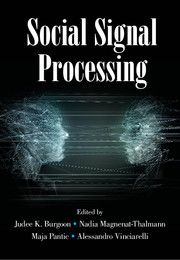Book contents
- Frontmatter
- Contents
- Contributors
- 1 Introduction: Social Signal Processing
- Part I Conceptual Models of Social Signals
- 2 Biological and Social Signaling Systems
- 3 Universal Dimensions of Social Signals: Warmth and Competence
- 4 The Vertical Dimension of Social Signaling
- 5 Measuring Responses to Nonverbal Social Signals: Research on Affect Receiving Ability
- 6 Computational Analysis of Vocal Expression of Affect: Trends and Challenges
- 7 Self-presentation: Signaling Personal and Social Characteristics
- 8 Interaction Coordination and Adaptation
- 9 Social Signals and Persuasion
- 10 Social Presence in CMC and VR
- Part II Machine Analysis of Social Signals
- Part III Machine Synthesis of Social Signals
- Part IV Applications of Social Signal Processing
- References
3 - Universal Dimensions of Social Signals: Warmth and Competence
from Part I - Conceptual Models of Social Signals
Published online by Cambridge University Press: 13 July 2017
- Frontmatter
- Contents
- Contributors
- 1 Introduction: Social Signal Processing
- Part I Conceptual Models of Social Signals
- 2 Biological and Social Signaling Systems
- 3 Universal Dimensions of Social Signals: Warmth and Competence
- 4 The Vertical Dimension of Social Signaling
- 5 Measuring Responses to Nonverbal Social Signals: Research on Affect Receiving Ability
- 6 Computational Analysis of Vocal Expression of Affect: Trends and Challenges
- 7 Self-presentation: Signaling Personal and Social Characteristics
- 8 Interaction Coordination and Adaptation
- 9 Social Signals and Persuasion
- 10 Social Presence in CMC and VR
- Part II Machine Analysis of Social Signals
- Part III Machine Synthesis of Social Signals
- Part IV Applications of Social Signal Processing
- References
Summary
Humans have long developed the automatic ability to prioritize social perception. Whether traveling ancient, dusty roads thousands of years past or meandering metropolitan blocks long after midnight, people must immediately answer two critical questions in a sudden encounter with a stranger. First, one must determine if the stranger is a friend or foe (i.e., harbors good or ill intent), and second, one must ask how capable the other is of carrying out those intentions. Since ancestral times, these two questions have been crucial for the survival of humans as social animals. The ability to quickly and accurately categorize others as friend or foe would have profoundly influenced the production and perception of social signals exchanged between agents. In developing computational analyses of human behavior, researchers and technicians alike can benefit from a thorough understanding of social categorization – the automatic process by which humans perceive others as friend or foe. This chapter will describe over a decade of research emerging from social psychological laboratories, cross-cultural research, and surveys that confirm two universal dimensions of social cognition: warmth (friendliness, trustworthiness) and competence (ability, efficacy) (see Fiske, Cuddy, & Glick, 2007, for an earlier review).
Foundational Research
Although appearing under different labels, the warmth and competence dimensions have consistently emerged in classical and contemporary studies of person perception (Asch, 1946; Rosenberg, Nelson, & Vivekananthan, 1968; Wojciszke, Bazinska, & Jaworski, 1998), construal of others’ past actions (Wojciszke, 1994), and voters’ approval of political candidates in both the United States (Abelson et al., 1982; Kinder & Sears, 1981) and Poland (Wojciszke & Klusek, 1996). Developing impressions of leaders also involves the warmth and competence dimensions, including image management (building trust), relationship development (warmth), and resource deployment (competence and efficiency) (Chemers, 1997).
Further examination of past and present research reveals the extent to which humans use warmth and competence dimensions in navigating the social world. Peeters (1983) was one of the first to describe two independent dimensions at the trait level by defining self-profitability (competence, advantageous to the self) and other-profitability (warmth and morality, advantageous to others) in perceivers’ social domain.
- Type
- Chapter
- Information
- Social Signal Processing , pp. 23 - 33Publisher: Cambridge University PressPrint publication year: 2017
References
- 8
- Cited by



